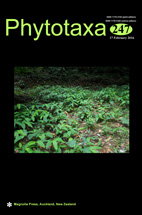Abstract
To evaluate the monophyly of the genus Pecluma, molecular data from species of Pecluma, members of the Polypodium dulce group, Phlebodium and other Polypodiaceae genera were analysed. The molecular study was based on four plastid regions, rps4+rps4–trnS, trnL–F, matK, and rbcL, and included sequences of 30 species of Pecluma (75% of the genus). The strongly supported phylogeny showed that three species of the Polypodium dulce group are nested inside the Pecluma clade and are sister to Pecluma species that bear pseudopeltate to peltate rhizome scales. Until now, these types of scales were not known to occur in Pecluma recurvata, P. hygrometrica and P. chnoophora, which were previously described as having basifixed rhizome scales. The results show that Pecluma, as currently circumscribed, is a paraphyletic genus, and some species from the Polypodium dulce group should be transferred to it. This study also confirmed the position of Pecluma chnoophora (considered Polypodium chnoophorum by some authors). In order to treat Pecluma as a monophyletic genus, this paper proposes a new generic circumscription and four new combinations for species previously recognized as Polypodium: Pecluma dulce, P. hartwegiana, P. longepinnulata and P. rhachipterygia.

